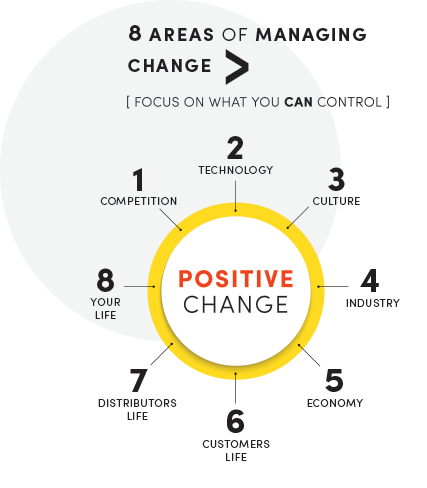A leader’s job is to build the foundation to ensure the legacy and future of the company.
As the adage goes, change is the only constant in life. Ray Kurzweil, the director of engineering at Google and arguably the world’s #1 futurist, notes that “the future will be far more surprising than most people realize.” The reason it will be more surprising, he argues, is “because few observers have truly internalized the implications of the fact that the rate of change itself is accelerating.”
The stronger the “DNA of Change and Innovation” is for a company, the better it will be for its future.

In his book titled, The Singularity Is Near, Mr. Kurzweil cites that the change in the short run might appear linear, but it becomes exponential over time. As you can see from the chart below, we are beginning the second phase of change when linear change in the short term turns into exponential change in the long term.
To put this chart in context, 20 years from now, the rate of change will be 4x what it is now. Differently put, for someone who is about 40 today, when they’re 60 in 2040, the rate of paradigm change will be 4x what it is now. They will experience a year of change (by today’s standards) in three months. For someone who is 10 today, when they’re 60, they’ll experience a year of change in 11 days.
Change for Direct Selling and Network Marketing
I have been in direct selling and network marketing for over three decades. Change is not a new concept for us. While change has always been a constant in business, the reality is that the marketplace will not adjust to how we have historically run our businesses. Even worse, the failure to change will magnify the speed of how much a company lacks relevancy over time. The failure to evolve has often been termed as a “slow death” of a company. Today the consequences for failure to evolve are more drastic and faster to the future of any company. The critical message for all legacy companies is to embrace change now!
I built the chart below on the trends driving change we face today in direct selling. The timeless forces driving change today are the fundamentals of acquiring a customer, retaining a customer, recruiting new reps and keeping those reps engaged in our business are timeless. However, how they are practiced in the marketplace is changing quickly.
We are seeing a major shift in the merger of the online and offline aspects of our business. A few months ago, I wrote an article for DSN that discussed this concept, The Dawn of the Phygital Movement in Direct Selling. We are seeing technology and data play a bigger role in direct selling companies internally and with their field. The DSA’s Digital Transformation Study released earlier this year noted the average company is spending about 8 percent of revenue on technology which is almost a 400 percent increase to what that was six years ago. Some of the bigger companies are spending 13-18 percent. In addition, we are seeing an increased level of competition for new entrepreneurs as companies use an independent contractor entrepreneurial model to build a salesforce. The impact of these trends is in their infancy, and their importance will magnify in the coming years. This is another reason why waiting to make key changes is a dangerous decision for any legacy company.

Two Core Obstacles to Change for Legacy Companies
Change is especially challenging for legacy companies. They face unique obstacles to change vs. startups and early-stage companies. Below are the two primary obstacles I find when working with legacy companies.
Obstacle 1: Lack of Understanding of How to Change
Change is a process that I mapped out in the diagram.

Step #1 is an analysis of what needs to change. This is where your team can identify and analyze the area or areas in your company that need to change.
Step #2 is the “breakthrough.” This is the most important part of the change process. A breakthrough is defined as a moment in time where there is an absolute commitment to change. With change, it is often important to burn the boat, so you cannot retreat to the “island of safety.” This is so important because without this level of resolve, it is only a matter of time before some obstacle defeats change.
Step #3 is to define a plan. There is an important concept when it comes to change management. That concept is that speed kills when it violates key fundamentals. So often, change needs to be managed in more of a long-term process than a “big bang” approach to change management. Our industry is masterful at selling hope and selling change is no different. It is important not to over promise and under deliver. If you do, you will likely create trust gaps that are massive roadblocks and make change virtually impossible.
Step #4 is to execute the plan in an effective way to minimize risk and maximize the results you want to see from change. Business is an execution game. You need the right voices in leadership driving change, and it is essential that these leaders are the voices for your company. You also need a talented and committed team to execute the plan.
Step #5 is to measure the results of change. While intuition has value, data is key to recognizing the best path forward. Plan to continue the change process to start step #1 over again. This is an effective way to create a “DNA of Change” vs. thinking that change has some endpoint. While some change is an event, most change is an ongoing process.
Obstacle 2: Understanding and Overcoming Fear
There are two types of fear. The first is fear that is evolutionary and is defined by our flight or fight response. The second and most common fear in business is “programmed fear.” All our brains work in a similar way and are derived from our experiences in life. We focus on something, and then our brain asks What does this mean? This is how our belief system is created and this controls many of the decisions and actions we take in life. When our beliefs are driven by repetition and emotions, they become more powerful to our brain and often become the “sacred cows” that stop change. This is why it is often said that the seven most expensive words in business are “we have always done it this way.”

One of the biggest fears is tied to the “J-Curve.” The concept of a J-Curve is that the adoption of changes will drop revenue and profitability. Leaders often see this as too big of a risk rather than an investment into relevancy and a better future for the company and all those involved with it. Change favors bold leadership but punishes those types of leaders if change is done too quickly or recklessly.
When it comes to fear, one of the biggest obstacles I see with companies is the fear of legacy leaders leaving their company. Many of these leaders have long-term relationships with their companies. They were promised a path to passive income, and once they earn it, they fight to protect it. This is a more complicated discussion since it relates to managing change with this group. I cannot stress enough the importance that these leaders see embracing change as an investment into their future vs. change taking something away from them. This is a behavioral game, and there is an art form to how to play this game effectively.
Addressing fear requires compassion, listening and observation. To address fear, one ultimately needs a psychologically safe environment. The first step in creating a psychologically safe environment is to acknowledge that fear is a sane emotion. Lower your organization’s cost of fear by increasing the psychological safety of people who are part of it, including yourself.
Lessons and Insights
Over the last six years, I have been primarily focused on helping companies to evolve their business models. Along the way, I have learned a few key lessons from both my successes and my failures. A summary of these insights and lessons is listed below.

- Build a mission and vision tied to change. It should define the ultimate goals of what the company seeks to become in the future and its impact in the marketplace.
- It is important to build a “behavioral blueprint.” This is a document that lists all the behaviors you will expect and demand from those in your business. Ultimately this is your North Star for making decisions. If you fail to approach change without this blueprint, you will find that self-agendas and mindset of key leaders will dictate the decisions of the company. This makes change difficult and extremely political.
- In all change, there will be winners and losers. Managing the emotions of both is critical. Buy-in and alignment are critical with key stakeholders.
- There are 3 cancers in business: drama, division and entitlement. You can effectuate change catering to people who drive these behaviors.
- The ultimate decision maker for any company will likely determine the direction and extent of change. The limitation of change lies in their hands.
- Focus on what you can control or influence. When it comes to the field, influence works much better than control.
- Change happens in the trenches, not in the boardrooms.
- Trust is built with a series of wins. The more wins, the easier it gets to execute change. This creates possibilities that were likely improbable during the initial change process.
- It is best to be proactive to managing change. If you wait for change to be forced onto a company, the process of change becomes much more challenging.
- If you refuse to embrace change, the future will likely penalize everyone involved with your company. Your legacy will likely be defined by your inability to evolve and how your leadership led to the demise of your company.
- Avoid the tendency to have a new hero as the voice of change. Change should be about practicing the behaviors you want in your company and practicing fundamentals in a relevant way.
In the end, the areas below are always in a constant state of change. The stronger the “DNA of Change and Innovation” is for a company, the better it will be for its future. Culture is the ultimate differentiator in direct selling and network marketing. It is the foundation for its future.
As leaders, our job is to build the foundation to ensure the legacy and future of the company. This is the responsibility of any good leader. While the evolution of any legacy company is a difficult process, the longer a company waits, the more difficult change will become over time. DSN

Gordon Hester is a direct selling industry veteran, lecturer, consultant and an accomplished author. He is on the DSA Research Committee, the DSA Government Relationship Committee and is on the Board of the DSEF. Hester owns a stack technology company, Shapetech Solutions.
From the October 2021 issue of Direct Selling News magazine.


